Repurposing the selective estrogen receptor modulator bazedoxifene to suppress gastrointestinal cancer growth
- PMID: 30885958
- PMCID: PMC6460354
- DOI: 10.15252/emmm.201809539
Repurposing the selective estrogen receptor modulator bazedoxifene to suppress gastrointestinal cancer growth
Abstract
Excessive signaling through gp130, the shared receptor for the interleukin (IL)6 family of cytokines, is a common hallmark in solid malignancies and promotes their progression. Here, we established the in vivo utility of bazedoxifene, a steroid analog clinically approved for the treatment of osteoporosis, to suppress gp130-dependent tumor growth of the gastrointestinal epithelium. Bazedoxifene administration reduced gastric tumor burden in gp130Y757F mice, where tumors arise exclusively through excessive gp130/STAT3 signaling in response to the IL6 family cytokine IL11. Likewise, in mouse models of sporadic colon and intestinal cancers, which arise from oncogenic mutations in the tumor suppressor gene Apc and the associated β-catenin/canonical WNT pathway, bazedoxifene treatment reduces tumor burden. Consistent with the proposed orthogonal tumor-promoting activity of IL11-dependent gp130/STAT3 signaling, tumors of bazedoxifene-treated Apc-mutant mice retain excessive nuclear accumulation of β-catenin and aberrant WNT pathway activation. Likewise, bazedoxifene treatment of human colon cancer cells harboring mutant APC did not reduce aberrant canonical WNT signaling, but suppressed IL11-dependent STAT3 signaling. Our findings provide compelling proof of concept to support the repurposing of bazedoxifene for the treatment of gastrointestinal cancers in which IL11 plays a tumor-promoting role.
Keywords: colon cancer; gastric cancer; gp130; interleukin‐11; interleukin‐6.
© 2019 The Authors. Published under the terms of the CC BY 4.0 license.
Conflict of interest statement
The authors declare that they have no conflict of interest.
Figures

- A
Effect of bazedoxifene (BZA) on IL11‐induced and STAT3‐dependent pAPRE‐firefly luciferase reporter activity in HEK293T cells expressing human IL11Rα. Cells were co‐transfected with a non‐responsive Renilla luciferase plasmid. Results are expressed as relative luciferase units (RLU), that is, firefly luciferase activity normalized against Renilla luciferase activity in each individual culture.
- B
Effect of BZA treatment on proliferation of IL11 stimulated BAF/03 murine B‐cell lines, as determined by MTS‐assay. IL6 stimulation was used as a positive control. Cells were engineered to express human either IL6Rα or IL11Rα, respectively.
- C
Effects of BZA treatment, as determined by MTS‐assay, on parental BAF/03 cells stimulated with IL3, of LIF receptor (LIFR)‐expressing cells stimulated with LIF, or of cells expressing the constitutive active L‐gp130 construct.

- A
Crystal structure of the extracellular domains of the IL6 hexameric signaling complex (PDB ID: 1P9M; Boulanger et al, 2003), depicted in cartoon format. The signaling complex consists of two molecules each of IL6 (cream colored), IL6Rα (magenta), and gp130 (one colored gray and the second yellow).
- B
90° rotation about the x‐axis from the view shown in (A). IL6 binds with its specific IL6Rα subunit via interaction Site I and with gp130 via Site II and Site III. Bazedoxifene has been proposed to interact with Site III, thereby disrupting the interaction of IL6 and IL11 with gp130 (Li et al, 2014; Wu et al, 2016).
- C
Proposed binding of IL11 to gp130 via Site III residues. The structure of IL11 (PDB ID: 4MHL, orange ribbon structure; Putoczki et al, 2014) was superimposed on IL6 in the hexameric receptor complex.
- D
Close‐up view of the Site III interaction sites between IL6 (cream ribbon, amino acid residues in black) or IL11 (orange ribbon, amino acid residues in orange) with gp130 (gray ribbon, amino acid residues in blue). The side chains of some of the residues at the Site III interface are shown as sticks.
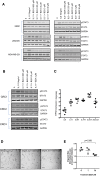
- A
Effects of bazedoxifene (BZA) on IL11‐stimulated STAT3 activation (pSTAT3) in gastric (MKN1), colon (LIM2405), and breast (MDA‐MB‐231) cell lines.
- B
Effects of bazedoxifene (BZA) on IL11‐stimulated STAT3 activation (pSTAT3) in primary cell cultures of isolated colon cancer epithelial cells of three individual colorectal cancer (CRC) patients.
- C
mRNA expression levels of IL6, IL11, IL6R, IL11R, IL6ST encoding gp130 and SOC3, a STAT3‐regulated gene in epithelial cells derived from six colorectal cancer patients.
- D
Effects of BZA treatment on IL11‐dependent growth of human colon cancer organoids. Organoids were cultured for 6 days in the presence of IL11 (50 ng/ml) and then for a further 7 days in IL11 plus the indicated concentration of BZA. Representative bright‐field microscopy images of organoid cultures at 7 days after BZA treatment. Scale bar = 300 μm.
- E
Relative changes in organoid size after 7 day treatment with vehicle control or BZA as described in (D). Data are mean ± SEM, n = 3 individual cultures, one‐way ANOVA, Dunnett's comparison test.
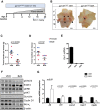
- A
Schematic representation of experimental setup. Intestinal‐type gastric cancer occurs spontaneously in homozygous gp130 Y757F mice from 4 week of age with 100% penetrance, and tumor‐bearing mice were treated with bazedoxifene (BZA) between weeks 13–20 at 3 mg/kg.
- B
Representative whole mounts of pinned‐out stomachs and opened along the outer curvature, from mice treated with vehicle (VEH) or BZA as described in (A). Tumors are indicated by arrow heads. F, fore stomach; C, corpus; A, antrum; SI, small intestine. Scale bar = 5 mm.
- C, D
Total tumor burden (C) and multiplicity (D) determined in individual 20‐week‐old mice from vehicle‐ and BZA‐treated cohort as indicated in (A). Each symbol represents an individual mouse of the indicated gender. Data are mean ± SEM, n = 7, exact P‐values from unpaired Student's t test.
- E
ERα mRNA (esr1) levels in tumors collected from the gastric antrum of mice from the vehicle‐ and BZA‐treated cohorts. ERα expression in the mammary tumor cell line 67NR is provided as a positive control.
- F
Western blot analysis of tumor lysates from tumors collected in (B) for the activated (phosphorylated) isoforms of signaling proteins as well as for the STAT3 target genes survivin, BclXL, and cyclin D1. Each lane corresponds to tumors pooled from an individual mouse. Blots were reprobed for β‐actin as a loading control.
- G
Changes in mRNA expression of IL11‐regulated STAT3 target genes in tumors from vehicle and BZA‐treated mice. Expression is normalized to mean value of vehicle‐treated mice. Data are mean ± SEM, n = 5, P‐values obtained from unpaired Student's t test.

- A
Representative hematoxylin‐ and eosin‐stained cross sections through the glandular stomach of 20‐week‐old gp130 Y757F mice that were treated with either bazedoxifene (BZA) or vehicle control (VEH) for 7 consecutive weeks. Scale bars = 1 mm.
- B
Representative immunohistochemistry staining for proliferative (Ki67 positive) and apoptotic (TUNEL positive) epithelium and those cells with high levels of the transcriptionally active pSTAT3 isoform (3+ intensity score) in sections of gastric tumors from mice as treated in (A). Immunohistochemical staining was quantified by Aperio analysis as outlined in the Materials and Methods section. Scale bars = 100 μm. Data are mean ± SEM, with n = 5 mice per cohort, P‐value derived from unpaired Student's t test.

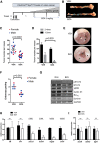
- A
Schematic representation of experimental setup. Colon cancer occurs in adult Cdx2 CreERT2; Apc flox mice 10–14 days after tamoxifen administration (1 mg/day for 3 consecutive days) and associated induction of Cre recombinase activity to confer bi‐allelic inactivation of the Apc tumor suppressor gene. Bazedoxifene (BZA) treatment was initiated 14 days post‐tamoxifen administration and lasted for two consecutive weeks.
- B
Representative examples of colons (left) and cecum (right) of vehicle‐ (VEH) and BZA‐treated mice as described in (A). Scale bar = 10 mm.
- C, D
Quantification of total tumor number in the colon of individual mice of the indicated gender (C), and when classified according to the size of individual tumors (D) at the end of 2 weeks of BZA treatment (mean ± SEM, n = 12 untreated controls, n = 13 BZA‐treated group, unpaired Student's t test). Each symbol represents an individual mice of the indicated gender.
- E, F
Representative endoscopy images of tumor‐bearing mice 2 weeks after vehicle or BZA treatment. Arrowheads indicate tumors (E). Endoscopy score of tumor burden as described in the Materials and Methods section (F) (Unpaired Students T test).
- G
Western blot analysis of tumor lysates from (C) for the activated (phosphorylated) isoforms of signaling proteins, as well as for the STAT3 targets survivin, BclXL, and cyclin D1. Each lane corresponds to tumors pooled from an individual mouse.
- H, I
Changes in mRNA expression of target genes regulated by STAT3 (H) or the canonical WNT/β‐catenin pathway (I) in vehicle‐ and BZA‐treated mice. Expression is normalized to mean value of vehicle‐treated mice. Data are mean ± SEM, n = 5 per group, P‐values from unpaired Student's t test.
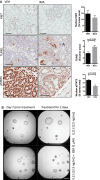
- A
Representative immunohistochemistry staining for proliferative (Ki67 positive) and apoptotic (TUNEL positive) epithelium and those cells with high levels of the transcriptionally active pSTAT3 isoform (3+ intensity score) in tumor sections of mice as treated in Fig 5A. Immunohistochemical staining was quantified by Aperio analysis as outlined in the Materials and Methods section. Scale bars = 100 μm. Data are mean ± SEM, with n = 5 mice per cohort, P‐value derived from unpaired Student's t test.
- B
Representative images of colon cancer organoids derived from Apc Min mice grown for 7 days in the presence of IL11 (12.5 ng/ml) alone or in combination with 1 μM bazedoxifene (BZA) for a further 2 days. Scale bar = 500 μm.

- A
Quantification of tumor numbers in the small intestinal of adult Lgr5 CreERT2; Apc flox mice occurs 10–14 days after tamoxifen administration (1 mg/day for 3 consecutive days) and the associated induction of Cre recombinase activity to confer bi‐allelic Apc inactivation. Bazedoxifene (BZA) treatment (3 mg/kg, 3 times per week) was initiated 14 days post‐tamoxifen and lasted for 2 consecutive weeks. Mono‐allelic Bmi1 ablation reduces tumor burden in Lgr5 CreERT2; Apc flox;Bmi1 +/− mice when compared to their fully Bmi1‐proficient littermates. Each symbol represents an individual mice of the indicated gender. Data are mean ± SEM, n = 5 untreated controls, n = 7 BZA‐treated group of Lgr5 CreERT2; Apc flox mice and n = 5 Lgr5 CreERT2; Apc flox;Bmi1 +/−, P‐values obtained from unpaired Student's t test).
- B
Assessment of canonical WNT/β‐catenin signaling in SW480 human colon cancer cells which harbor bi‐allelic APC impairment mutations and were transfected with either the firefly luciferase pTOPFlash positive or the negative control pFOPFlash control reporter construct alongside a non‐responsive Renilla luciferase plasmid. Cells were then treated for 24 h with IL11 (10 ng/ml) and BZA (1 μM) as indicated. Results are expressed as relative luciferase units (RLU), that is, firefly luciferase activity normalized against Renilla luciferase activity in each individual culture. Data are mean ± SEM, n = 3, ***P = 0.0001, ns = not significant, ANOVA with Dunnett's comparisons test.
- C
Assessment of STAT3 signaling in SW480 human colon cancer cells transfected with the pAPRE reporter and the non‐responsive Renilla‐luc construct. Cells were then treated for 24 h with IL11 (10 ng/ml), BZA (1 μM), or the Jak1/2 inhibitor AZD1480 (1 μM) as indicated. Results are expressed as RLU, that is, firefly luciferase activity normalized against Renilla luciferase activity in each individual culture. Data are mean ± SEM, n = 3, ***P = 0.0001, ns = not significant, ANOVA with Dunnett's comparisons test.
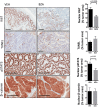
Similar articles
-
Bazedoxifene as a Novel GP130 Inhibitor for Pancreatic Cancer Therapy.Mol Cancer Ther. 2016 Nov;15(11):2609-2619. doi: 10.1158/1535-7163.MCT-15-0921. Epub 2016 Aug 17. Mol Cancer Ther. 2016. PMID: 27535971 Free PMC article.
-
Bazedoxifene as a novel GP130 inhibitor for Colon Cancer therapy.J Exp Clin Cancer Res. 2019 Feb 8;38(1):63. doi: 10.1186/s13046-019-1072-8. J Exp Clin Cancer Res. 2019. PMID: 30736824 Free PMC article.
-
Down-regulating IL-6/GP130 targets improved the anti-tumor effects of 5-fluorouracil in colon cancer.Apoptosis. 2018 Jun;23(5-6):356-374. doi: 10.1007/s10495-018-1460-0. Apoptosis. 2018. PMID: 29777330
-
Epithelial gp130/Stat3 functions: an intestinal signaling node in health and disease.Semin Immunol. 2014 Feb;26(1):29-37. doi: 10.1016/j.smim.2013.12.006. Epub 2014 Jan 13. Semin Immunol. 2014. PMID: 24434062 Review.
-
Molecular pathways: IL11 as a tumor-promoting cytokine-translational implications for cancers.Clin Cancer Res. 2014 Nov 15;20(22):5579-88. doi: 10.1158/1078-0432.CCR-13-2492. Epub 2014 Jul 29. Clin Cancer Res. 2014. PMID: 25074610 Review.
Cited by
-
New insights into IL-6 family cytokines in metabolism, hepatology and gastroenterology.Nat Rev Gastroenterol Hepatol. 2021 Nov;18(11):787-803. doi: 10.1038/s41575-021-00473-x. Epub 2021 Jul 1. Nat Rev Gastroenterol Hepatol. 2021. PMID: 34211157 Review.
-
Repurposed Drugs in Gastric Cancer.Molecules. 2022 Dec 30;28(1):319. doi: 10.3390/molecules28010319. Molecules. 2022. PMID: 36615513 Free PMC article. Review.
-
Vanillin-Based Indolin-2-one Derivative Bearing a Pyridyl Moiety as a Promising Anti-Breast Cancer Agent via Anti-Estrogenic Activity.ACS Omega. 2023 Feb 8;8(7):6968-6981. doi: 10.1021/acsomega.2c07793. eCollection 2023 Feb 21. ACS Omega. 2023. PMID: 36844536 Free PMC article.
-
The IL6-like Cytokine Family: Role and Biomarker Potential in Breast Cancer.J Pers Med. 2021 Oct 24;11(11):1073. doi: 10.3390/jpm11111073. J Pers Med. 2021. PMID: 34834425 Free PMC article. Review.
-
Bazedoxifene as a Potential Cancer Therapeutic Agent Targeting IL-6/GP130 Signaling.Curr Oncol. 2024 Sep 25;31(10):5737-5751. doi: 10.3390/curroncol31100426. Curr Oncol. 2024. PMID: 39451730 Free PMC article. Review.
References
-
- Alorro MG, Pierce TP, Eissmann MF, Dijkstra C, Dickins RA, Ernst M, Buchert M, Masson F (2017) Generation of an inducible mouse model to reversibly silence Stat3. Genesis 55: 4 - PubMed
-
- Barton VA, Hudson KR, Heath JK (1999) Identification of three distinct receptor binding sites of murine interleukin‐11. J Biol Chem 274: 5755–5761 - PubMed
-
- Becker C, Fantini MC, Schramm C, Lehr HA, Wirtz S, Nikolaev A, Burg J, Strand S, Kiesslich R, Huber S et al (2004) TGF‐beta suppresses tumor progression in colon cancer by inhibition of IL‐6 trans‐signaling. Immunity 21: 491–501 - PubMed
-
- Bernardi AI, Andersson A, Stubelius A, Grahnemo L, Carlsten H, Islander U (2015) Selective estrogen receptor modulators in T cell development and T cell dependent inflammation. Immunobiology 220: 1122–1128 - PubMed
-
- Boulanger MJ, Chow DC, Brevnova EE, Garcia KC (2003) Hexameric structure and assembly of the interleukin‐6/IL‐6 alpha‐receptor/gp130 complex. Science 300: 2101–2104 - PubMed
Publication types
MeSH terms
Substances
LinkOut - more resources
Full Text Sources
Miscellaneous

